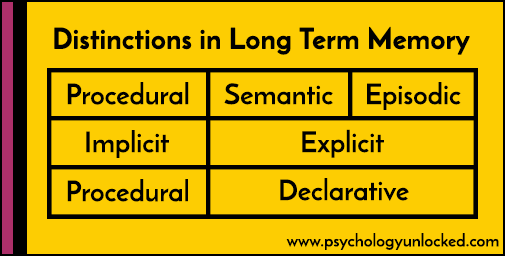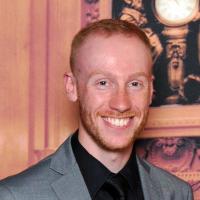QUICK READ
In 1972, Endel Tulving proposed one of the most influential models of Long Term Memory. Tulving became the 36th most cited psychologist in the 20th century, and his model continues to influence research today.
When Long Term Memory was included in Atkinson and Shiffrin’s (1968) Multi Store Model of Memory, it was presented as a single, unified store. That is to say, theoretically there was one Long Term Memory that dealt with all memories in the same way.
Researchers quickly questioned this assumption, in light of anecdotal evidence, such as why can you remember how to cycle a bike after years of no practice but forget the right word to use in the middle of a conversation – surely these two pieces of information are not dealt with equally?
Endel Tulving proposed one of the earliest, and notably influential, distinctions in Long Term Memory. His theory divided Long Term Memory into three separate processes:
1. Procedural – responsible for knowing how to do things.
2. Semantic – understanding the outside world and meanings.
3. Episodic – our personal memories of events.
Subsequent research by Cohen and Squire (1980) simplified Tulving’s model into two distinct types of long term memory:
1. Declarative – knowing a piece of information that can be consciously brought to mind and declared.
2. Procedural – non-declarative memory for how to do something.
When it comes to cognitive models, it is important for researchers to be able to prove that the theoretical components of the model are distinct.
In this example, some supporting evidence for Cohen and Squire’s two types of long term memory comes from research on amnesic patients. These patients are unable to create new declarative memories, but their procedural memory capabilities are unimpaired.
DETAILED EXPLANATION
When Atkinson & Shiffrin (1968) included the Long Term Memory store in their Multi-Store Model of memory, they stated that it was unlimited, in size and duration.
Atkinson & Shiffrin’s model formalised an understanding of memory that had been a focus of academic psychological interest for almost a century.
Unlike Sensory Memory, which is so extremely fleeting that it was at first overlooked, and Short Term Memory (or Working Memory), which focus exclusively on the present, Long Term Memory is, perhaps, the memory store that separates us most from the animal kingdom.
It allows us to recall facts from years ago, make inferences about new situations based on what we have learned in the past, and enables us to ride a bike or drive a car.
As with Short Term Memory, Atkinson & Shiffrin’s concept of a single, unified long term store has since been challenged and it is now unanimously accepted that Long Term Memory is something of an umbrella term for a series of processes and stores.
Tulving (1972) initially proposed a three distinct elements of Long Term Memory, which subsequent researchers have simplified into two categories: Declarative and Procedural memories. Other researchers have suggested splitting LTM into Implicit and Explicit Memories. But before delving into divisions, it will be helpful to start our discussion of Long Term Memory with an understanding of its capacity, duration and coding.
Capacity of Long Term Memory
It is generally thought that LTM has an unlimited capacity. This means that a healthy, neurotypical individual is able to continuously add memories into LTM without having to remove old memories to make space for the new ones. Long Term Memory is a depository store rather than an active store, so when memories or facts are required in the present, the information is retrieved from LTM and returned, temporarily, to Working Memory.
A note to students: When writing about memory, be sure to demonstrate that you understand the differences between models of memory. It is possible to discuss the interaction between Long Term Memory and Short Term Memory or Working Memory – just remember that Working Memory is Baddeley & Hitch’s model, whereas Short Term Memory was suggested as part of Atkinson & Shiffrin’s Multi-Store Model. Don’t say STM when you mean WM, and the other way round!
Duration of Long Term Memory
Another remarkable feature of Long Term Memory is that it can seemingly last an entire lifetime. Information can be held in LTM for anything from a few minutes to a number of years. Some interesting ideas about the duration of LTM – though I shall save the detail for another article – include the idea of false memories (thinking we remember something when, if fact, we don’t) and social memories (memories that last longer than a single lifetime because they are socially shared and therefore situated in the social sphere, not the individual).
Coding of Long Term Memory
Whereas Short Term Memory seems to be largely coded acoustically, Long Term Memory appears to be coded primarily in semantic code. This means that LTM is encoded in terms of verbal meaning, rather than what the information acoustically sounded like. For example, immediately after an event you may recall that your tour guide called the Eiffel Tower ‘tall’, but three months later you may not remember the exact word used, but the meaning: tall, giant, towering, sky-scraper, large. You remember the meaning (semantic) rather than the word (acoustic). There is also evidence to suggest that some information in Long Term Memory is encoded visually and acoustically, but to a lesser extent than semantically – this suggests that LTM is able to adapt to the requirements of specific information.
An acronym-paradigm study by Bower & Springston (1970)1 lends supporting evidence to the suggestion of a semantically-encoded LTM. The researchers presented college students with a letter sequence which they had to recall. In one condition, participants were shown random letters (sku, hg, kps), whereas the experimental condition were shown letter sequences which were also well-known acronyms (fbi, ibm, phd). The students were able to recall the semantically-meaningful letter sequences more reliably than the random letters, suggesting that LTM supports the chunking capabilities of Short Term Memory using semantically-coded information.
Breaking Down Long Term Memory

Long Term Memory is not a unified store. Therefore, theorists have developed ideas about how the store might be split up – both in a cognitive sense and biologically. The original, and influential, distinctions in LTM were presented by Tulving (1972). Tulving suggested LTM contained (1) procedural, (2) semantic, and (3) episodic memories.
Subsequent research has simplified Tulving’s three components into two: (1) declarative and (2) procedural (Cohen & Squire, 1980). Declarative memories are those which are consciously experienced or learned – they might be autobiographical, about things that have happened to us personally (episodic memories), or impersonal facts that we have learned (semantic memories), such as the meaning of words. Procedural memories are unconscious in nature and involve motor skills, such as riding a bike and learning to swim.
An alternative way of dividing LTM is between explicit and implicit memories. Explicit memories are those that have been consciously learned (times tables, for example), whereas implicit memory does not rely on conscious awareness – it is a memory for information that is incidentally or unintentionally learned (there is certainly a significant overlap between implicit and procedural memory in the literature).
